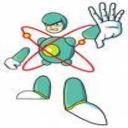Yahoo Answers is shutting down on May 4th, 2021 (Eastern Time) and beginning April 20th, 2021 (Eastern Time) the Yahoo Answers website will be in read-only mode. There will be no changes to other Yahoo properties or services, or your Yahoo account. You can find more information about the Yahoo Answers shutdown and how to download your data on this help page.
Trending News
Can someone explain E=MC sq. It's Einsteins formula for the atomic bomb I think but how can C the speed of light be squared?
5 Answers
- OldPilotLv 75 years ago
The c^2 term falls out of the derivation of the formula. Here is one way to derive the equation using nothing but algebra and high school physics:
The Derivation of E=mc2
Perhaps the most famous equation of all time is E = mc2. The equation is a direct result of the theory of special relativity, but what does it mean and how did Einstein find it? In short, the equation describes how energy and mass are related. Einstein used a brilliant thought experiment to arrive at this equation, which we will briefly review here.
First of all, let us consider a particle of light, also known as a photon. One of the interesting properties of photons is that the have momentum and yet have no mass. This was established in the 1850s by James Clerk Maxwell. However, if we recall our basic physics, we know that momentum is made up of two components: mass and velocity. How can a photon have momentum and yet not have a mass? Einstein’s great insight was that the energy of a photon must be equivalent to a quantity of mass and hence could be related to the momentum.
Einstein’s thought experiment runs as follows. First, imagine a stationary box floating in deep space. Inside the box, a photon is emitted and travels from the left towards the right. Since the momentum of the system must be conserved, the box must recoils to the left as the photon is emitted. At some later time, the photon collides with the other side of the box, transferring all of its momentum to the box. The total momentum of the system is conserved, so the impact causes the box to stop moving.
Unfortunately, there is a problem. Since no external forces are acting on this system, the centre of mass must stay in the same location. However, the box has moved. How can the movement of the box be reconciled with the centre of mass of the system remaining fixed?
Einstein resolved this apparent contradiction by proposing that there must be a ‘mass equivalent’ to the energy of the photon. In other words, the energy of the photon must be equivalent to a mass moving from left to right in the box. Furthermore, the mass must be large enough so that the system centre of mass remains stationary.
Let us try and think about this experiment mathematically. For the momentum of our photon, we will use Maxwell’s expression for the momentum of an electromagnetic wave having a given energy. If the energy of the photon is E and the speed of light is c, then the momentum of the photon is given by:
1.1) Pphoton = E/c
The box, of mass M, will recoil slowly in the opposite direction to the photon with speed v. The momentum of the box is:
1.2) Pbox = Mv
The photon will take a short time, Δt, to reach the other side of the box. In this time, the box will have moved a small distance, Δx. The speed of the box is therefore given by
1.3) v = del x / del t
By the conservation of momentum, we have
1.4) M*(del x/del t) = E/c
If the box is of length L, then the time it takes for the photon to reach the other side of the box is given by:
1.5) del t = L/c
Substituting into the conservation of momentum equation (1.4) and rearranging:
1.6) M*del x = EL/c^2
Now suppose for the time being that the photon has some mass, which we denote by m. In this case the centre of mass of the whole system can be calculated. If the box has position x1 and the photon has position x2, then the centre of mass for the whole system is:
1.7) x-bar = (Mx1 +mx2)/(M+m)
We require that the centre of mass of the whole system does not change. Therefore, the centre of mass at the start of the experiment must be the same as the end of the experiment. Mathematically:
1.8) (Mx1+mx2)/(M+m) = (M(x1-del x) + mL)/(M+m)
The photon starts at the left of the box, i.e. x2 = 0. So, by rearranging and simplifying the above equation, we get:
1.9) m*L = M*del x
Substituting (1.4) into (1.9) gives:
1.10) m*L = EL/c^2
E/c^2 = m
E = mc^2
- electron1Lv 75 years ago
The explosion of an atomic bomb is the result of nuclear fission reaction. In a nuclear fission reaction, the mass of the products is less than the mass of reactants. If you go the website below, you can learn more about how this happens.
http://chemistry.tutorvista.com/nuclear-chemistry/...
E = m * c^2
The letter m is the difference of the mass of reactants and the mass of products. In a nuclear fission reaction, the products are more stable than the reactants. When a nucleus is more stable, its mass is less that it was before the nuclear fission reaction occurs. The reaction is from this website. If you were to determine the number of protons and neutrons on both sides the equation, you would find they are the same. My point is that this number is the same, but the mass has decreased. This always happens when a nuclear fission reaction occurs.
92U235 + 0n1 → → 3 0n1 + 36Kr92 + 56Ba141 + ENERGY
The following website has more information and describes the nuclear reaction that occurs in an atomic bomb. I hope this is helpful for you!
- Andrew SmithLv 75 years ago
When Einstein developed the special theory of relativity to explain the speed of light in inertial frames of reference there were many consequences.
Mass, length and time were all relative to the observer.
This in turn implied that bodies containing more energy had more mass than bodies with less energy. It was easily derived that if the premise of the theory was true then E = m c^2.
Now remember that as the theory was to explain the unique properties of the speed of light it is hardly surprising that that speed appears in every transformation that comes from the theory.
- JulienLv 75 years ago
E: energy in joules (i.e. Newtons times metres)
M: mass in kilograms
c: speed of light in m/s
We already know how to transform kilograms into Newtons from Newton's gravitational constant. Then, from simple "dimensional analysis", it ends up that c can only be squared. Mc would not be in the same units than E, but Mc2 is.
- How do you think about the answers? You can sign in to vote the answer.
- 5 years ago
Why can't it be...its just a number. The equation merely explains the relation between energy and mass.




